Introduction
Every business today is searching for ways to maximize return on investment (ROI) while keeping costs under control. In a world where customer engagement directly influences revenue, two tools stand out: professional email marketing and customer relationship management (CRM) systems. When combined, these solutions create a powerful synergy that helps businesses build stronger relationships, close more sales, and retain customers for the long term. The ROI from Professional Email Marketing & CRM is not just about immediate profits, it’s about creating scalable, repeatable strategies for sustainable growth. This article explores the real impact of email marketing and CRM integration, the challenges businesses face, and the strategies that deliver measurable results. By partnering with a trusted technology partner like IT Company, organizations can implement these tools effectively and unlock their full growth potential.
Why ROI Matters in Modern Digital Marketing
ROI is the heartbeat of modern digital marketing strategies. Without clear measurement, businesses risk pouring resources into campaigns that don’t move the needle.
Why ROI Tracking Is Essential
- Budget Justification – Every dollar spent must show measurable value.
- Strategic Decision-Making – Helps identify which marketing efforts deliver the best results.
- Continuous Growth – Enables businesses to refine and scale successful strategies.
By integrating CRM with professional email marketing, businesses gain the transparency needed to measure ROI accurately and continuously optimize performance.
The Link Between Email Marketing & CRM Systems
Email marketing and CRM systems are often seen as separate tools, but they work best when combined.
- Email Marketing delivers targeted campaigns to prospects and customers.
- CRM Systems track customer data, sales history, and preferences.
- Integration ensures every email is based on real customer behavior and aligned with sales objectives.
The result? Smarter campaigns, stronger engagement, and higher ROI.
Understanding ROI in Email Marketing
Key Metrics That Define ROI
ROI from email marketing is measured using several performance indicators:
- Open Rates – How many recipients actually read your email.
- Click-Through Rates (CTR) – The percentage of readers who click links.
- Conversion Rates – How many complete the desired action (purchase, download, etc.).
- Customer Lifetime Value (CLV) – The long-term revenue a customer generates.
Calculating ROI
A simple formula to calculate ROI is: ROI = (Revenue from campaign – Cost of campaign) ÷ Cost of campaign × 100 For instance, a campaign costing $1,000 that generates $8,000 in sales results in a 700% ROI—showing the undeniable power of well-structured email campaigns.
Case Study Examples
- A retail company used CRM-driven segmentation to send tailored promotions and achieved a 25% boost in repeat sales.
- A SaaS provider automated onboarding emails and reduced churn by 18%, directly impacting long-term ROI.
The Role of CRM in Boosting Marketing ROI
Centralizing Customer Data
A CRM system acts as a single source of truth, housing customer history, preferences, and behavior. This enables marketers to craft hyper-relevant messages that resonate.
Personalization & Automation
CRM data fuels automated campaigns such as welcome sequences, cart abandonment reminders, and post-purchase follow-ups—all of which significantly improve ROI.
Tracking Customer Journeys
CRM tools provide visibility into each customer’s lifecycle, helping businesses identify upselling opportunities and maximize lifetime value.
Benefits of Combining Professional Email Marketing & CRM
Increased Lead Nurturing & Conversion Rates
Automated drip campaigns guide prospects through the buyer’s journey, turning warm leads into paying customers more effectively.
Improved Customer Retention & Loyalty
It costs far less to retain an existing customer than to acquire a new one. CRM-powered personalization fosters long-term loyalty.
Cost Savings & Operational Efficiency
By automating repetitive tasks and improving sales-marketing alignment, businesses reduce waste and maximize resource efficiency.
Challenges in Achieving High ROI from Email & CRM
While the benefits are clear, some businesses struggle to achieve desired ROI.
Common Pitfalls
- Sending mass, untargeted emails.
- Ignoring CRM insights in campaign planning.
- Poor adoption across sales and marketing teams.
Overcoming Challenges
- Invest in staff training.
- Select tools that integrate seamlessly.
- Work with partners like IT Company to ensure smooth implementation and ongoing support.
Strategies to Maximize ROI from Professional Email Marketing & CRM
Aligning Marketing & Sales Teams
With shared data, marketing can deliver qualified leads, and sales can close deals faster, increasing overall ROI.
Leverage Data Analytics
CRM insights highlight which campaigns resonate most with customers, allowing continuous optimization.
A/B Testing for Optimization
Testing subject lines, designs, and CTAs ensures campaigns stay relevant and effective.
Tools and Platforms That Deliver High ROI
Top Email Marketing & CRM Platforms
- HubSpot
- Active Campaign
- Salesforce Marketing Cloud
- Mailchimp with CRM integration
Key Features to Consider
- Seamless integration between email & CRM
- Advanced segmentation & personalization
- Reporting dashboards
- Automation workflows
IT Company helps businesses choose the right platforms, ensuring technology aligns with business goals.
Future Trends in Email Marketing & CRM ROI
AI & Predictive Analytics
AI is reshaping email marketing and CRM by predicting customer behavior, automating content personalization, and recommending the best time to send emails.
Hyper-Personalization
Tomorrow’s campaigns won’t just use a first name—they’ll anticipate needs based on browsing habits, purchase history, and engagement patterns.
Integration with Omnichannel Strategies
CRM-powered email marketing will connect seamlessly with SMS, social media, and chatbots to create consistent experiences across channels.
Conclusion:
The ROI from Professional Email Marketing & CRM Systems is undeniable—higher engagement, better conversions, cost efficiency, and stronger customer retention. By aligning these two powerful tools, businesses can transform their marketing from a guessing game into a predictable, revenue-generating engine. For organizations ready to elevate their digital strategies, the key lies in integrating these systems seamlessly and using them to their full potential. That’s where IT Company comes in—offering expertise, implementation, and ongoing support to ensure businesses unlock the true value of their investments. When executed correctly, professional email marketing and CRM are not just tools; they are catalysts for sustainable business growth and long-term profitability.

